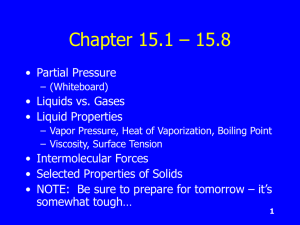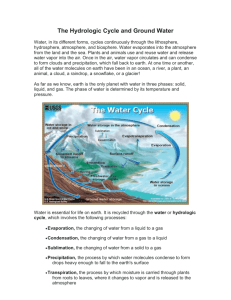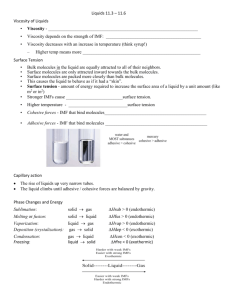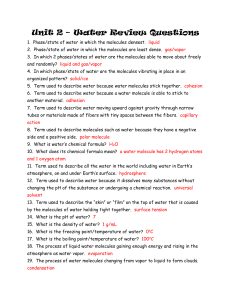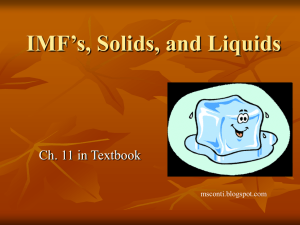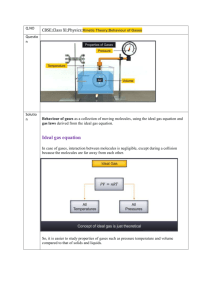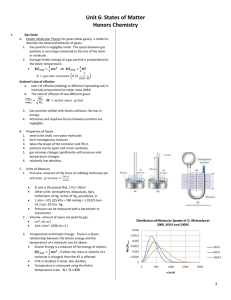Honors Chemistry
advertisement
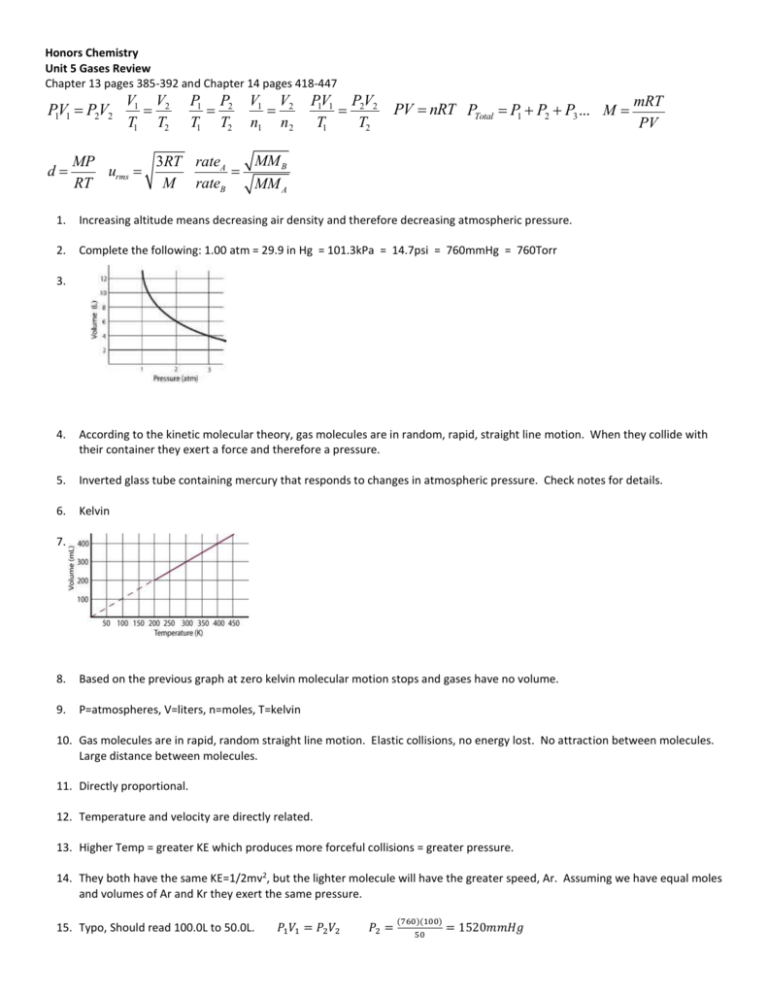
Honors Chemistry Unit 5 Gases Review Chapter 13 pages 385-392 and Chapter 14 pages 418-447 P1V1 = P2V2 d= V1 V2 = T1 T2 P1 P2 = T1 T2 V1 V2 = n1 n 2 P1V1 P2V2 = T1 T2 PV = nRT PTotal = P1 + P2 + P3 ... M = mRT PV MM B 3RT rateA MP = urms = M rateB RT MM A 1. Increasing altitude means decreasing air density and therefore decreasing atmospheric pressure. 2. Complete the following: 1.00 atm = 29.9 in Hg = 101.3kPa = 14.7psi = 760mmHg = 760Torr 3. 4. According to the kinetic molecular theory, gas molecules are in random, rapid, straight line motion. When they collide with their container they exert a force and therefore a pressure. 5. Inverted glass tube containing mercury that responds to changes in atmospheric pressure. Check notes for details. 6. Kelvin 7. 8. Based on the previous graph at zero kelvin molecular motion stops and gases have no volume. 9. P=atmospheres, V=liters, n=moles, T=kelvin 10. Gas molecules are in rapid, random straight line motion. Elastic collisions, no energy lost. No attraction between molecules. Large distance between molecules. 11. Directly proportional. 12. Temperature and velocity are directly related. 13. Higher Temp = greater KE which produces more forceful collisions = greater pressure. 14. They both have the same KE=1/2mv2, but the lighter molecule will have the greater speed, Ar. Assuming we have equal moles and volumes of Ar and Kr they exert the same pressure. 15. Typo, Should read 100.0L to 50.0L. 𝑃1 𝑉1 = 𝑃2 𝑉2 𝑃2 = (760)(100) 50 = 1520𝑚𝑚𝐻𝑔 16. This is Boyle’s Law. Since gas molecules are far apart they can respond to an increase in pressure on them by reducing their volume. 17. Ideal gases can be described by all the different gas equations we have 100% of the time under all conditions, whereas real gases can deviate from predicted behavior under very high pressure and low temperatures. 18. Consider the drawing to the right. a. Gas B must have a lower MM compared to gas A because gas B’s molecules are on average moving faster, even though each gas has the same KE. 3𝑅𝑇 Speed and temperature are directly related 𝑣 = √ b. 𝑀𝑀 . As temp increases, speed increases, (B) is at a higher temp. 19. P=1atm, T=273 K 𝑚𝑅𝑇 20. 𝑀 = 𝑃𝑉 𝑔 = 154.2 𝑚𝑜𝑙 21. Level of mercury rises as the atmospheric pressure increases. 𝑀𝑃 22. 𝑑 = 23. 24. 𝑉1 𝑇1 𝑉1 = = 𝑛1 27. 𝑃1 𝑉1 𝑇1 𝑉2 =.017L 𝑇2 𝑉2 =1139mL 𝑛2 𝑛𝑅𝑇 25. 𝑉 = 26. = √ = 1.78𝑔/𝐿 𝑅𝑇 𝑃 3𝑅𝑇 =√ 𝑀 = 28. 𝑉 = = 39.99𝐿 𝑃2 𝑉2 𝑇2 𝑛𝑅𝑇 𝑃 3(8.31)(298) .04401 = 410.44𝑚/𝑠 =538.8K = 76.55𝐿 𝑀𝑃 29. 𝑑 = = 1.96𝑔/𝑚𝑜𝑙 𝑅𝑇 30. Avogadro’s Law. More molecules means more collisions and therefore, more pressure. Volume then increases. Now gas molecules have fewer collision because of the increase in volume and pressure decreases to original value. 31. n, T 32. n,P 33. P,T 34. The sum of the individual pressures of gases in a container equals the total pressure. Also, the mole fraction of the individual gases represents the same ratio of the total pressure. In other words, if gas A represents 25% of the total # of moles of gases it also represents 25% of the total pressure. 35. 𝐶𝑂 + 2𝐻2 → 𝐶𝐻3 𝑂𝐻 36. 𝑉1 𝑛1 = 𝑉2 𝑛2 @STP 1mol=22.4L 1𝑚𝑜𝑙 44.01 𝑔 × 1𝑚𝑜𝑙𝐶𝐻3 𝑂𝐻 1𝑚𝑜𝑙𝐶𝑂 = 15L 37. 30.4𝑘𝑃𝑎 = 16.5𝑘𝑃𝑎 + 3.7𝑘𝑃𝑎 + 𝑃𝐶𝑂2 38. 68.5𝑔𝐶𝑂 × 𝑉1 = 75𝑚𝐿 𝑇1 = 298𝐾 =10.2kPa 𝑉2 = 𝑇2 = 273𝐾 (766)(75) 298 = (760)𝑉 273 =69.3𝑚𝐿 × 22.4𝐿 1𝑚𝑜𝑙 = 34.86𝐿 𝑃1 = 790𝑚𝑚𝐻𝑔 − 24𝑚𝑚𝐻𝑔 𝑃2 = 760𝑚𝑚𝐻𝑔 39. Balance equation: 2KClO3(s) ⟶ 3O2(g) + 2KCl(s) Determine the partial pressure of the O2 and then use the ideal gas law to find moles of O2. Convert moles of O2 to g of KClO3 required to react. 1. 754mmHg-19.835 mmHg= 734.165 mmHg 2. 3. (.966𝑎𝑡𝑚)(.650𝐿) (.0821)(295) −2 = 2.59 × 10−2 𝑚𝑜𝑙 𝑂2 2.59 × 10 𝑚𝑜𝑙 𝑂2 × 2𝑚𝑜𝑙𝐾𝐶𝑙𝑂3 3𝑚𝑜𝑙𝑂2 × 122.55𝑔𝐾𝐶𝑙𝑂3 1𝑚𝑜𝑙 = 2.11𝑔𝐾𝐶𝑙𝑂3 40. First, use ideal gas law to find moles of each gas. Second use ideal gas law to find total pressure. Next, use ideal gas law again 𝑃𝑉 𝑛𝑅𝑇 to find partial pressure of each gas. 𝑛 = 𝑡ℎ𝑒𝑛 𝑢𝑠𝑒 𝑃 = , then 𝑃𝑎 = 𝜒𝑎∙ 𝑃𝑡 𝑃𝐴𝑟 = 0.124 moles Ar 0.0826 moles He 𝑃𝐻𝑒 = 41. 𝑟𝑎𝑡𝑒 𝑁𝑒 𝑟𝑎𝑡𝑒𝐾𝑟 = √83.8 √20.18 𝑅𝑇 0.124 𝑚𝑜𝑙𝑒𝑠 0.2066 𝑚𝑜𝑙𝑒𝑠 0.0826 𝑚𝑜𝑙𝑒𝑠 0.2066 𝑚𝑜𝑙𝑒𝑠 𝑉 ∙ (5.05𝑎𝑡𝑚) = 3.03 𝑎𝑡𝑚 ∙ (5.05𝑎𝑡𝑚) = 2.02 𝑎𝑡𝑚 = 𝑁𝑒 𝑖𝑠 2.04 𝑡𝑖𝑚𝑒𝑠 𝑓𝑎𝑠𝑡𝑒𝑟 42. Both molecules show hydrogen bonding. The molecule on the right, propanol has additional carbons and hydrogens, therefore it has greater London dispersion forces. The greater the intermolecular force of attraction in a molecule, the higher its boiling point. 43. H2 H2S CHF3 NH3 only dispersion dipole-dipole dipole-dipole H-bonding 44. The stronger the IMF the weaker the vapor pressure exerted by the gaseous molecules. NaCl is ionc bonding, the strongest IMF, therefore; it would have the lowest vapor pressure. H2O and HF use H-bonding, HF is more polar (greater ∆𝐸𝑁) because F is more electronegative than O. HF would have the lower vapor pressure . Br2 and F2 would have the weakest IMF. LDF, so their vapor pressures would be the greatest. Since F 2 has the lowest molar mass it’s LDF attractions are weaker than Br2, therefore it would have the highest vapor pressure. 45. a) b) c) d) e) f) g) h) i) j) l26.7 kPa 6.65 kPa 75ºC 26.7 kPa 118ºC temperature at which the vapor pressure is 1 atm or 101.2kPa approx. 72ºC approx. 116ºC 70ºC (remember boiling occurs when Pvap=Patm) approx. 20kPa 46. Surface tension is related to strength of the IMF’s. The greater the IMF the higher the surface tension of the molecule. As you can see acetone is a dipole-dipole IMF and water is H-bonded, so water would have the higher surface tension. 47. Viscosity is related to strength of IMF also. Both molecules are nonpolar, so the IMF of attraction is LDF. Both molecules have the same molar mass so the only factor to consider is the surface area of the molecule. The greater the surface area the greater the viscosity. Because there is more points of contact for a larger surface area, more and stronger IMF attractions form. 48. Water. At any given temperature water’s vapor pressure is the lowest in comparison to the other two substances. Water has H-bonding the strongest IMF, therefore the lowest vapor pressure. 49. Most volatile means most easily vaporized into a gas, highest vapor pressure. At any given temperature pentane has a higher vapor pressure compared to the others. 50. First pentane would boil away, then tetrachloromethane and finally water. As the KE of the molecules increased the substance with the weakest IMF’s would go through a phase change into a gas most easily, followed by the others.
